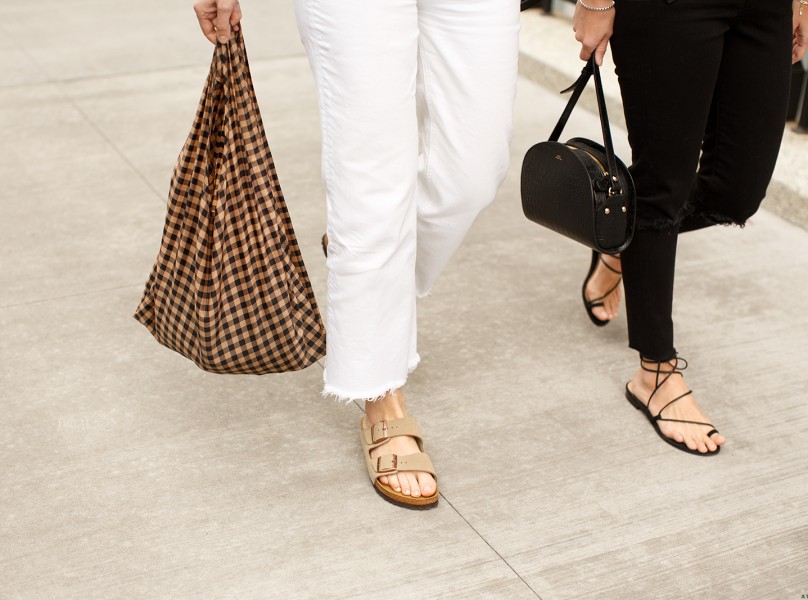How Much Beauty is Too Much Beauty?
4 years ago by
Are you a skin minimalist or do you love an extensive routine? Once upon a time, a skincare routine consisted of face wash and a moisturizer. In college (a long ago version of me), I was lucky if I remembered to wash my face at night. Now, the possibilities are endless, with morning and evening skincare routines consisting of a cleanser, toner, serum, eye cream, spot treatment, hyaluronic acid, moisturizer, sunscreen, essence, masks… and more.
Over the past few years, I’ve tried to maintain a minimal routine but from time to time, I can’t help but add a glossy and cleverly marketed product. There are so many ingredients and treatments I want to experiment with and subsequently go on about to you all in the form of a personal essay. In reality, due to a combination of time and money, I find it difficult and confusing to maintain an extensive routine.
There is a lot of misinformation on the internet and every beauty company is trying to sell us something. Case in point, in 2020, the global anti-aging market alone was estimated to be worth about 58.5 billion US dollars. We all want the holy grail product that will make us look younger, more beautiful, successful and in general solve all of our issues, but what does our skin really need? Are all the products in a fifteen step routine efficacious and/or necessary? Are we causing more damage to our skin by using too many products?
To find out how much beauty is too much beauty, we asked the experts – two board-certified dermatologists and a celebrity aesthetician, to answer all our questions. From product combinations to avoid to what to do if you’re experiencing a skin reaction, we break it all down below.
First things first, how do I know if I’m using too many skincare products?
You never want to throw your skin off balance, says board-certified dermatologist and surgeon, Dr. Dennis Gross. How do you know if your skin is off balance? “Skin that is out of balance appears inflamed, red and can sometimes have a rash or breakouts.” According to celebrity esthetician and founder of her eponymous skincare brand, Shani Darden, if you’re experiencing irritation or even breakouts, it could be from using too many products at once. It could also be from products that are not right for your skin and do not work synergistically, says Dr. Gross.
What do I do if I experience a reaction from a product or combination of products?
If you’re noticing skin irritation, “reduce the frequency that you’re using active treatments and focus on hydrating and soothing ingredients to help restore balance,” says Darden. Using too many active products can also lead to a compromised skin barrier, meaning that “the skin might be red, irritated, or even painful,” says Darden. “If products are stinging your face when you apply them, it may be that the barrier is compromised. Skin could feel tight or itchy as well.” A common culprit? Overuse of exfoliants. If you notice a new product is causing redness and flaking or other unusual symptoms, stop using it and see your dermatologist if it doesn’t resolve in a day or two, says Adarsh Vijay Mudgil, M.D., board-certified dermatologist and founder of Mudgil Dermatology.
Is it important to have a skincare routine every day or is skipping days a necessary break?
Both Darden and Dr. Gross agree that consistency is the key to results. “Consistency is truly important,” says Darden, “however, it is important to listen to your skin. If your skin is feeling a little dry or irritated, skip your retinol or exfoliating product that evening, instead opting for a hydrating serum and moisturizer only.” Skincare should be customized and doesn’t fit a one size fits all approach.
What is one product that you should never skip?
Sunscreen! According to Dr. Mudgil, SPF is “the single most important skincare product. An SPF 30 with titanium or zinc oxide is ideal.” Sunscreen use can help prevent skin cancer by protecting you from harmful ultraviolet rays. According to the American Academy of Dermatology (AAD), it is estimated that one in five Americans will develop skin cancer in their lifetime, which is a terrifying statistic. The AAD recommends using a sunscreen with an SPF of at least 30, which blocks 97% of the sun’s UVB rays. Moral of the story – wear sunscreen daily, even if you’re not going to the beach.
How long should you use a product to truly understand if it’s working?
“It takes about a month to see the effect of any product on the skin,” says Dr. Mudgil. For skincare products, instant gratification isn’t always a realistic possibility. So don’t give up if you’re not seeing results immediately. Take a scientific approach and observe the effect of one product before moving on to the next.
Are there products that counteract each other?
Avoid mixing retinol with Vitamin C, benzoyl peroxide, salicylic acid, or glycolic acid. One combination of products that should not be used directly together is Vitamin C and Retinol, a Vitamin A derivative. Individually, these are active ingredients that can benefit your skin but together, they can cause skin irritation, redness and sensitivity when layered on top of each other. This also depends on the concentration of each ingredient and your skin’s tolerance, as in, are you just starting to dabble in actives or are you accustomed to multi-step skincare routines?
Darden recommends using the products at different times of the day to get the full benefits of each ingredient, without the irritation that comes with a layered approach. “Vitamin C is best used during the day to get the full antioxidant benefits [since it] helps to offset environmental stressors such as pollution and UV exposure,” says Darden. Vitamin C, a potent antioxidant, protects the skin against free radicals and repairs skin and helps with brightening dark spots (hyperpigmentation).
“Retinol is best used at night [since] it can cause some sensitivity to the sun [plus] you’ll get the most benefit out of a retinol while using at night when your skin is in repair mode,” she adds. Retinol promotes skin-cell turnover to help minimize the appearance of fine lines, reduces signs of aging, helps treat acne, and overall contributes to a refreshed appearance. It should also be introduced slowly and gently, depending on skin tolerance. If your skin becomes dry, hold back and decrease frequency of use.
Another option Darden recommends when using multiple active products, such as a retinol and a chemical exfoliant, is to alternate nights to avoid causing any irritation to the skin. The key to any good skincare routine is to understand the purpose of each ingredient and use them at the right frequency to get the most benefit without side effects.
If you’re on a prescription retinol, do not use benzoyl peroxide. This will lead to skin inflammation and could potentially cause damage to your moisture barrier, says Dr. Gross. If you are “using a chemical exfoliant with alpha and beta hydroxy acids in addition to a retinol, use the exfoliant in your morning routine and the retinol at night,” he adds. Additionally, avoid using retinol with glycolic acid and salicylic acid as they can dry out and irritate the skin, adds Dr. Mudgil.
Are there products that block absorption of another product when used together?
One example of products that block absorption of each other is using a moisturizer before a retinol, however this can lead to a positive result. Using moisturizer before retinol can “buffer the effects of retinol,” says Darden. She suggests using “a little moisturizer beforehand, followed by retinol, to reduce irritation, dryness or redness.”
What are common mistakes consumers make with skincare?
“One of the most important things you can do for your skin is to figure out exactly which product works best for your skin,” says Darden. In other words, tailor your skincare routine to what you specifically need. It can be tempting to see a skincare routine on social media and assume it can be directly correlated to your own skin type. I’ve certainly been guilty of the same but “what works for someone else, may not work great for your skin,” both Darden and Dr. Gross agree.
“Using too many products or too many of the wrong products for your skin type can cause a lot of irritation. If your skin is inconsistently oily and dry or breaking out, it could be because you’re using the wrong products for your skin type,” says Darden. You know you’re using the right product types and number of products when your skin is “balanced, glowing and hydrated.” It takes trial and error to figure out what works.
What does it mean to be a smart consumer of skincare?
“Research the products you’re using and figure out what is best for your skin,” says Darden. Instead of using products because they’re trendy or someone else is using them, “use what is best for your skin to get the best results,” she adds. It’s important to understand your skin type and what ingredients you actually need. Many online resources offer this education. Dr. Gross has free masterclasses in which he discusses assessing skin types and skin concerns such as aging, acne and hyperpigmentation.
Can’t I just use a moisturizer and be done with it?
Maybe not. In a single center clinical study published in the Journal of Clinical and Aesthetic Dermatology comparing the use of a moisturizer plus hydrating serum versus a moisturizer alone, investigators found a statistically significant improvement in facial skin parameters such as reduction in dryness and increased skin softness after two weeks of combined use compared to the group who used moisturizer alone. Ah, data.
I’m new to skincare. Where should I start?
An ideal skincare routine is based on your specific needs. “Start with the basics, such as a cleanser, sunscreen, and a great moisturizer for your skin type and a treatment serum, [such as] a retinol or acne treatment,” says Darden. Serums can be a splurge but they have “the highest concentration of actives,” she adds. Serums contain concentrated amounts of active ingredients and are lightweight products that absorb quickly into your skin and can help target specific skin concerns. Whenever I’ve done 10+ step routines in the past, I’ve had trouble keeping up and essentially set myself up for failure. “Keeping your regimen simple to start will make it easier to develop a daily morning and night routine habit,” says Dr. Gross. “Once that is achieved, you can begin adding additional products like an eye cream or at-home LED device to give your skin an additional boost,” he adds.
Darden recommends adding a retinol, such as her product, Retinol Reform, which has “2.2% encapsulated retinol and provides multiple anti-aging benefits without the dryness and irritation often experienced with other retinol products.” Retinol should be used in the evening before bed as it can also cause photosensitivity. Retinol helps to “reduce the appearance of fine lines and wrinkles, uneven tone, dullness, blemishes and acne scars,” says Darden. Retinol Reform also contains 2% lactic acid, which “helps to brighten and smooth skin, so you get both immediate benefits and long-term results.” If your skin is feeling on the dryer side, she recommends adding hyaluronic acid serum to “plump up and hydrate the skin.” Then, add a moisturizer.
The last step in your routine should be sunscreen. Shani recommends wearing sunscreen every single day, no matter what and loves Supergoop’s Play Everyday Sunscreen, “which is lightly hydrating yet doesn’t cause congestion.”
I’m overloaded with skincare. What should I do?
“Reduce what you’re using and stick to the basics, such as a great cleanser, sunscreen, moisturizer, active treatment and an antioxidant serum,” says Darden. Darden suggests adding in active products such as retinol, vitamin C or exfoliants “very slowly to pinpoint what actually works. It’s the only way to narrow down products to determine what is best for your skin type specifically.”
Patch testing is also recommended when introducing active products to your skincare routine. Dr. Gross recommends looking at the active ingredients in the products you are using. “The key ingredient pillars are vitamin C, retinol, hyaluronic acid, niacinamide, and a physical SPF block. Look for products that use a cocktail of these ingredients to pare down your regimen.” He recommends looking at clinical brands that combine these ingredients instead of trying to play chemist and mixing and matching yourself.
My takeaway? The routine that truly works is the one you are able to do consistently. As for how much beauty is too much beauty? It’s up to the individual to decide.


































